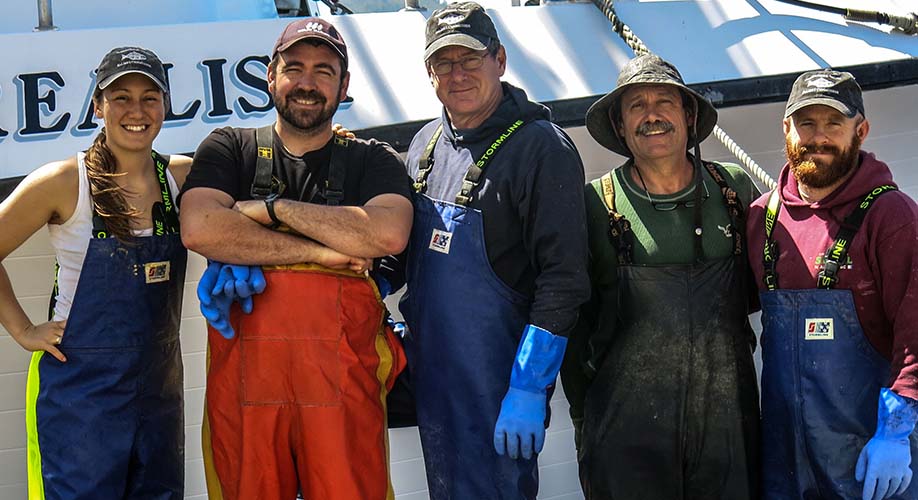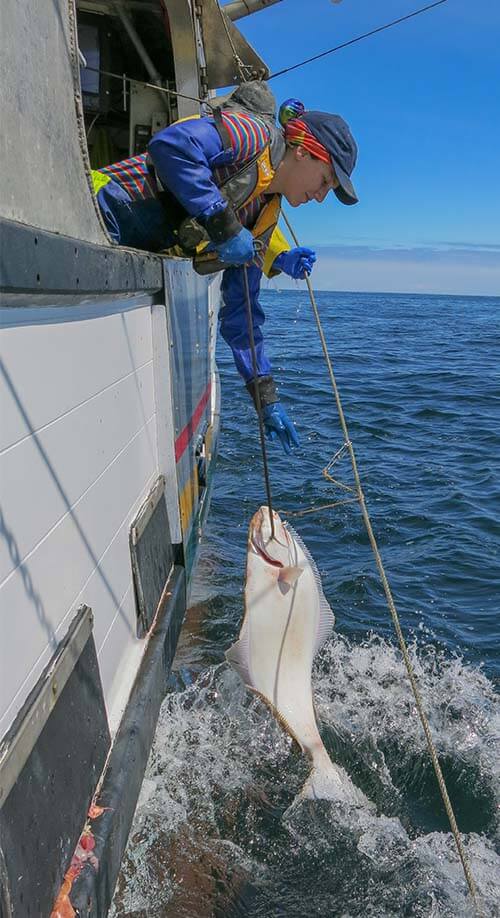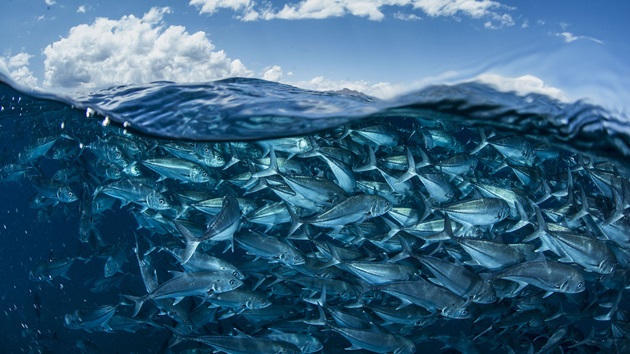How the fish harvesters behind the sustainable seafood movement work cross-sector with researchers, policymakers, environmentalists, and advocates to improve our ocean’s health.

Left to right: Tiare Boyes, Angus Grout (Tiare’s Cousin), Pete Wyness, Dave Boyes (Tiare’s father), Tim Courtier (Tiare’s partner).
Fishermen are Natural Problem Solvers
For the last 19 years, I have gone to sea as a fish harvester. I represent only one generation of commercial Pacific halibut fishermen that date back to at least the 1880s.
Each year, my family sets sail on our fishing boat headed towards the middle of Hecate Strait, located on the West Coast of Canada. In the middle of the strait, there are no safe harbors or islands to shelter behind. The weather can be extreme and unpredictable, and the water is ice cold—even in the summer. When we have a problem on board, we need to be able to work together to come up with a solution or we might not make it home.
This solution-oriented work ethic is not unique to my family or my fishery. In fact, it is a quality I have consistently seen across fishing communities around the world.
As fish harvesters, we collectively seem to understand a simple, yet daunting truth behind our livelihoods: When you’re working on the ocean, you either work to solve your problems or you sink, literally or figuratively.
Tackling the Problem of Bycatch
In Canadian Pacific waters more than 56 species of groundfish (including 37 species of rockfish) co-exist along or near the ocean floor. Halibut is one of the largest species and is prized for its firm but tender texture and slightly sweet, delicate flavour. Its versatility is celebrated in many kitchens for the endless options it offers chefs to innovate. It’s also an important species for the many British Columbians who depend on it for their livelihoods.
The fact that all these species cohabit in the same area can make fishing for any one of them challenging when you need to avoid the others (reduce bycatch) to operate sustainably.
While the Pacific halibut stock itself was well managed at the time, in 2003, concerns arose about a lack of scientific data that could provide a better understanding of the impacts that groundfish fishing (like the Pacific halibut fishery I’m part of) was having on some rockfish species. While certain rockfish species have been specifically targeted as part of a highly valued commercial fishery, some have been a bycatch species of other groundfish fisheries. Without catch data, there was a lack of certainty that fishing activity wasn’t having a negative effect on the long-term health of rockfish stocks.
In response, Canada’s
Department of Fisheries and Oceans (DFO), working with fish harvesters and the conservation sector, identified five guiding principles that all Pacific groundfish fisheries had to address to continue operating. The principles were aimed at increasing accountability, improving bycatch tracking, and instilling a precautionary approach to managing rockfish populations.
Commercial groundfish harvesters had two options: address these five principles ourselves, or risk having DFO shut down the fishery. Without this fishery, thousands of people could lose their jobs and Canadians would lose access to a local, healthy marine protein.
The solve? Fishermen formed the
Commercial Industry Caucus (CIC) - a group of fishermen representing the seven sectors of the Pacific groundfish fishery, working alongside federal and provincial governments to build a bottom-up solution that accounted for the needs of both people and planet.
This new process totally reorganized how our fisheries operated and allowed us to meet the new regulations and ensure we were not over-harvesting while also maintaining our livelihoods. It included regular reporting to a larger body of government, CIC representatives, environmentalists, and First Nations coastal communities.
Fisheries Funding Research
The increased collaboration between fishermen and government bodies helped set the foundation for a more holistic approach to sustainability, which was a good start. But there was still a lack of government funding for the research needed to evaluate the success of the new measures put in place.
The BC groundfish fishermen stepped in and once again began working collaboratively with DFO. Harvesters agreed to fund and conduct the data collection needed using their own vessels and experienced fishermen.
This work has resulted in invaluable data that now helps provide a better understanding of other groundfish species the fishery encounters.
To ensure the credibility of the data, DFO collects and analyzes it and collaborates with international fisheries scientists on additional peer-reviewed stock assessments (a collection of biological and fisheries data used in the management of fish stocks). In this way, fisheries’ participation in scientific research is instrumental in allowing DFO to make informed decisions on how to better manage the fishery.
Accountability, Transparency, and Collaboration
Today, all Pacific commercial groundfish fisheries require full accountability for the totality of their catch – every target and non-target (bycatch) fish has to be logged, whether it’s retained to be sold or released back into the water. There is also 100% at-sea video monitoring, an on-board logbook of all catch, and 100% dockside verification of every fish that’s offloaded. Lastly, an independent company validates and compares the at-sea video footage to the information in the vessel logbook and the landing data at the dock.
This increasingly detailed process for collecting and verifying fishing data allows for more advanced stock assessment procedures to be used, and more specific and accurate conclusions to be drawn about the overarching sustainability of the fisheries.
New stock assessments have been able to confirm that rockfish stocks once considered “at-risk” actually fall within the “healthy zone”—proving the positive impact of the collaborative effort between fisheries and other partners beyond the shadow of a doubt.
It is important to acknowledge that this shift was a direct result of commercial fish harvesters, government, and the environmental sector working together to find bottom-up solutions that worked for all parties. No one group could have achieved this alone.
With everyone doing their part, our Pacific waters will be able to remain productive for generations to come without threatening the health of other marine populations or the aquatic environment.

Tiare Boyes fishing for Wild Pacific Halibut on board her dad’s vessel "Borealis I"
What the Future Will Look Like
Sustainability is an ongoing journey, especially when it comes to a natural resource like wild fish that depends on dynamic, ever-changing environments. Without changes to the management of our fishery and an increased investment in science-backed solutions, the wild Pacific halibut fishery would likely not have been able to achieve
Marine Stewardship Council (MSC) certification. The fact that we’ve maintained it for over 10 years now is thanks to ongoing efforts and a commitment to constant improvements by everyone involved.
The wild Pacific halibut fishery is a world leader in sustainable fisheries management, and fishermen helped build it into what it is today. We genuinely care about our fish stocks, our marine resources, and the ecosystems they inhabit.
It is a personal point of pride for me, and a testament to the great work my fellow harvesters are doing on—and off—the water to maintain and increase the sustainability of our operations. I am also proud of our excellent track record working collaboratively with government, environmental groups, and other stakeholders who are equally committed to protecting our livelihoods and the resources we rely on.
I would like consumers to know the amount of effort that fish harvesters, like my family, put into not only safely harvesting this nutritious and delicious marine protein, but the effort we put in working with scientists, politicians, policymakers, the conservation sector, and researchers to ensure we can continue to harvest this valuable marine resource with respect and an aim to deliver a collective Big Blue Future.
When you purchase an MSC certified seafood product, you are supporting fishermen like me to make our fisheries better every day.
Sources:
- Boyes, T. 2018. Shifts in spatio-temporal fishing behaviour in the Canadian Pacific Halibut hook and line fishery as a result of a choke species. Master of Resource Management, University of Akureyri, University Centre of the Westfjords, Iceland.
- Robyn E. Forrest, Ian J. Stewart, Cole C. Monnahan, Katherine H. Bannar-Martin, and Lisa C. Lacko. Evidence for rapid avoidance of rockfish habitat under reduced quota and comprehensive at-sea monitoring in the British Columbia Pacific halibut fishery. Canadian Journal of Fisheries and Aquatic Sciences. 77(8): 1409-1420. https://doi.org/10.1139/cjfas-2019-0444
- Mawani, T. (2009, September). Evaluation of the Commercial Groundfish Integration Pilot Program in British Columbia (Masters Thesis). Royal Roads University, Royal Roads University




